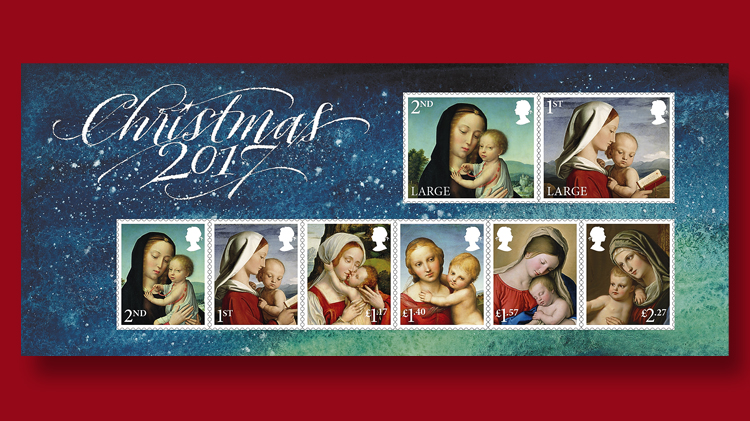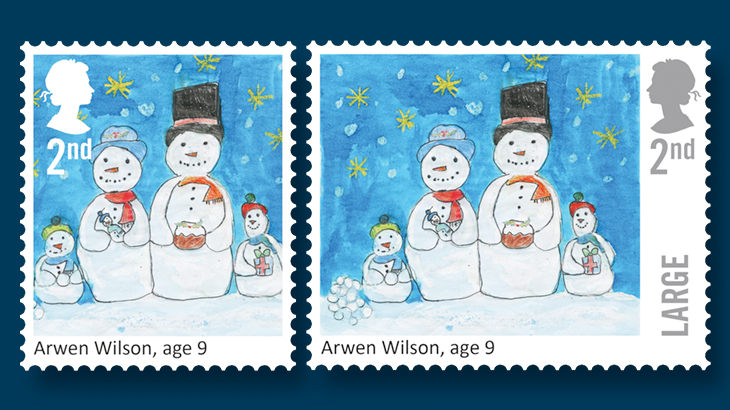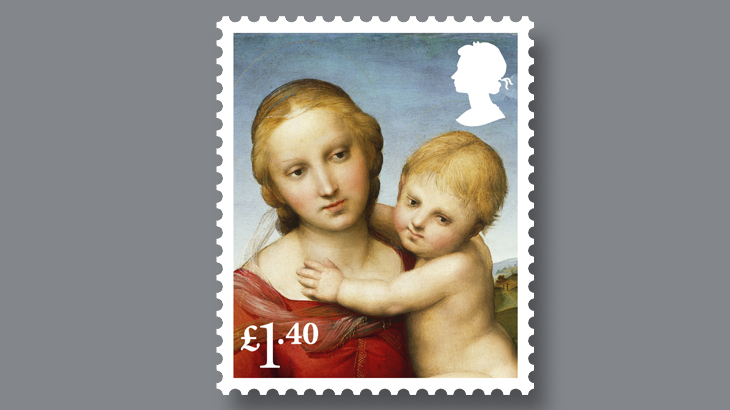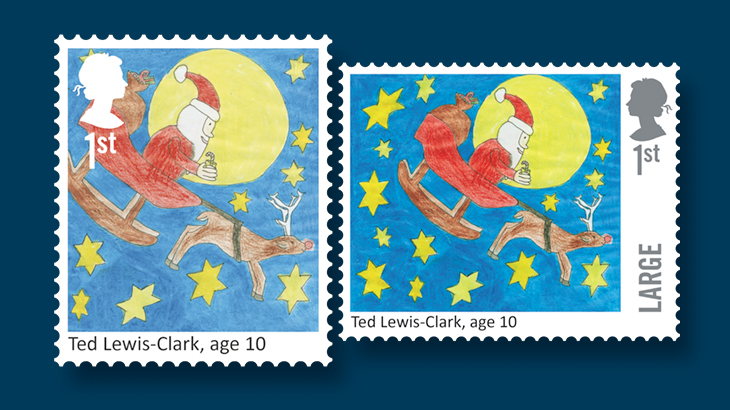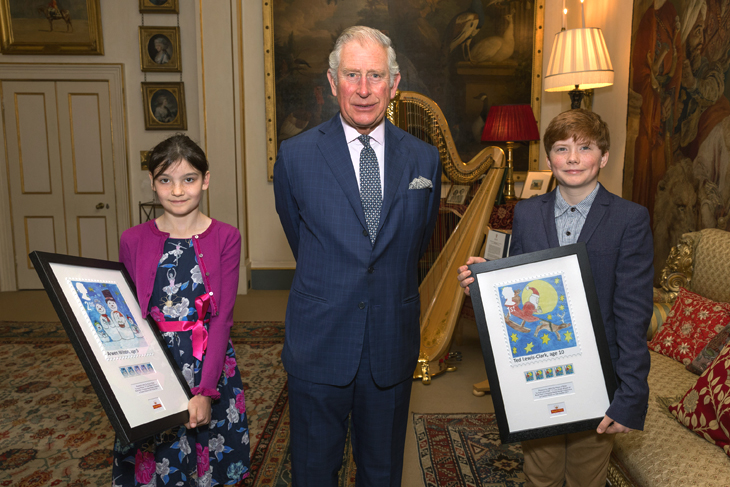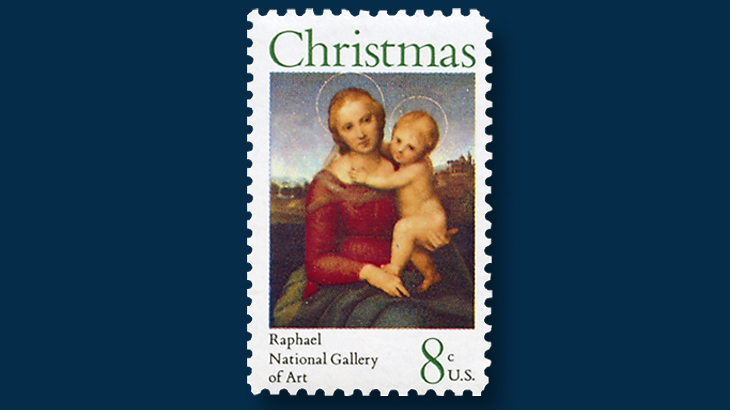World Stamps
Britain’s new Christmas stamps feature children’s designs and famous paintings
By Denise McCarty
A new Christmas stamp from Great Britain showing a detail of The Small Cowper Madonna by Raphael may look familiar to collectors in the United States. This painting from the National Gallery of Art in Washington, D.C., also was featured on a U.S. Christmas stamp in 1973 (Scott 1507).
The British stamp is among a dozen Christmas stamps issued Nov. 7 by Royal Mail.
Four of the stamps show the two winning entries in a children’s design competition, and eight stamps reproduce Madonna and Child paintings.
As reported in the Aug. 7 Linn’s, page 11, Ted Lewis-Clark, age 10, and Arwen Wilson, 9, won the Christmas stamp design contest arranged by Royal Mail.
Connect with Linn’s Stamp News:
Sign up for our newsletter
Like us on Facebook
Follow us on Twitter
More than 200,000 entries from children ages 4 through 11 were received in the competition. These were narrowed down to the top two from 12 different United Kingdom regions, and, from those 24 designs, Prince Charles chose the two winners.
The prince presented framed examples of their stamps to Lewis-Clark and Wilson at a Nov. 7 ceremony held at Clarence House in Westminster.
Lewis-Clarks’ design “Santa Claus on his sleigh on a starry night” is featured on the nondenominated first-class stamp for standard mail and the nondenominated first-class stamp for large mail.
“The Snow Family” by Wilson appears on the nondenominated second-class stamp for standard mail and the nondenominated second-class stamp for large mail.
The stamps for large mail are physically larger than those for standard mail and also include the word “large” on them. The stamps for standard-size mail measure 24 millimeters by 28mm, and the large-mail stamps are 34mm by 28mm.
Royal Mail defines standard-size mail as letters not exceeding 24 centimeters in length, 16.5 centimeters in width and 0.5 centimeters in thickness with a weight limit of 100 grams. Large letters can be up to 35.3 centimeters in length, 25 centimeters in width and 2.5 centimeters thick with a weight limit of 750 grams.
The current rates are 56p for standard-size second-class letters, 65p for standard-size first-class letters, 76p for second-class large letters; and 98p for first-class large letters.
The nondenominated first- and second-class Madonna and Child stamps also are available in two versions: one for standard mail and the other for large mail.
The first-class stamps depict a detail from The Madonna and Child by 19th-century Scottish artist William Dyce.
This painting is part of the Royal Collection. According to the Royal Trust, which looks after the Royal Collection, this oil-on-canvas hangs in the queen’s bedroom at Osborne House. It was purchased by Prince Albert in 1845.
The website of the Royal Collection, www.royalcollection.org.uk, describes the painting: “While the pose here is tender, the focus is more on religious devotion than maternal affection, the spiritual rather than the sensual. The Virgin reads a Bible passage referring to the stock of Jesse (Isaiah 11) and the child points to Mary as the origin of Christ.”
The two second-class Madonna and Child stamps show a detail from The Virgin and Child. This oil-on-canvas work is believed to have been painted around 1520 and is attributed to Gerard David. Now part of the Prado Museum in Madrid, Spain, this painting was once part of the collection of King Phillip II (1527-98), who sent it to Royal Site of San Lorenzo de El Escorial in 1577.
The £1.17 stamp features a detail of a painting that is still part of the collection at El Escorial, Virgin Mary with Child attributed to 15th-century Flemish artist Quinten Massys.
The £1.46 stamp depicts the detail of The Small Cowper Madonna, so named because it was sold to George Nassau Clavering-Cowper, the third Earl Cowper around 1780 and stayed in the family until the early 20th century.
The painting dates from Raphael’s years in Florence (1504-08).
Reproduced on the £1.57 stamp is a detail of The Sleep of the Infant Jesus by 17th-century Italian painter Giovanni Battista Sassoferrato. The painting was acquired by the Louvre in 1816.
The high denomination of the set, £2.27, depicts a detail from St. Luke Painting the Virgin by Austrian artist Eduard Jakob von Steinle. Part of the Royal Collection, it was painted in 1851 for Prince Albert, who gave it to his wife, Queen Victoria, as a birthday gift that year.
The denominated stamps meet the following rates: £1.17, letters to Europe up to 20 grams and international letters up to 10 grams; £1.46, international mail up to 20 grams and domestic small parcels and printed papers up to 750 grams; £1.57, letters to Europe up to 100 grams; and £2.27, international letters up to 100 grams.
Royal Mail Group Ltd. designed all of Britain’s 2017 Christmas stamps. The Madonna and Child stamps were based on initial concept ideas by Kate Stephens.
De La Rue Security Print printed the stamps by gravure.
The denominated Madonna and Child stamps (£1.17, £1.46, £1.57 and £2.27) are in separate sheets of 50.
The nondenominated stamps for are in four different combined sheets of 50 (one sheet for standard-size first-class mail, a sheet for first-class large mail, a sheet for standard-size second-class mail and a sheet for second-class large mail).
Each sheet contains the Madonna and Child stamps in the top pane of 25, and Children’s Designs stamps in the bottom pane of 25.
Royal Mail divides its sheets of 50 into panes of 25 for sale to customers.
The stamps are self-adhesive and perforated 14.5 by 15.
A souvenir sheet, measuring 179mm by 74mm, contains all eight of the Madonna and Child stamps with moisture-activated gum. Supple Studio designed the selvage of this sheet; the typography is by John Stevens.
The Madonna and Child stamps also were issued in a sheet of 20 stamps (eight first-class and eight second-class standard mail stamps and one each the other denominations) and se-tenant labels with traditional Christmas greetings, against a celestial background.
A sheet of 20 Children’s Design stamps and labels contains 10 of each design. Items related to the Christmas season and to design are pictured in the selvage.
The nondenominated first-class and second-class stamps for standard-size mail also were issued in two booklets of 12.
The booklet of first-class stamps includes six Children’s Design stamps and six Madonna and Child stamps. Similarly, the other booklet includes six of each of the second-class stamps.
International Security Printers printed the booklet stamps by gravure.
Other products to be offered in conjunction with the Christmas stamps include first-day covers, a set of 13 postcards reproducing the designs of the stamps and the souvenir sheet, and a presentation pack with all 12 stamps.
To order the Christmas stamps and related products, visit Royal Mail’s shop on the Internet. Ordering information also is available from Royal Mail, Tallents House, 21 S. Gyle Crescent, Edinburgh, EH12 9PB, Scotland.
Royal Mail’s two agencies in the United States are Interpost, Box 420, Hewlett, NY 11557; and the British Stamp Service in North America, 1 Unicover Center, Cheyenne, WY 82008.
MORE RELATED ARTICLES
Headlines
-
US Stamps
Oct 7, 2024, 3 PMMcMurtrie dismissed as APS education director following Sept. 21 arrest
-
US Stamps
Oct 7, 2024, 12 PMVasiliauskas named president of Mystic Stamp Co.
-
US Stamps
Oct 6, 2024, 5 PMApgar souvenir card available
-
US Stamps
Oct 6, 2024, 4 PMFirst Continental Congress and U.N. stamps receive Scott catalog numbers
